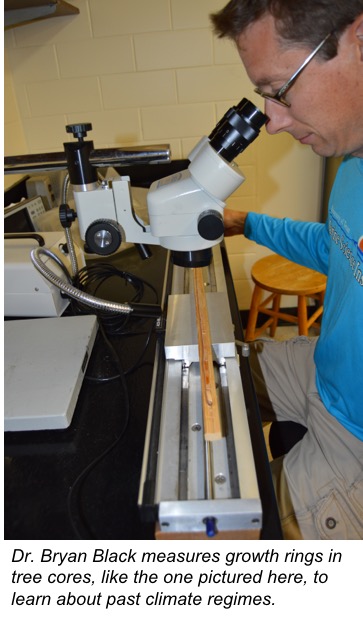New research shows that climate is tightening its grip on western North America, causing ecosystems from land to the ocean to become more synchronous with one another.  In a study just released from the journal of Global Change Biology, Dr. Bryan Black and coauthors explain how climate is increasingly controlling ecosystem behavior. “We’ve found that land, rivers, and oceans are all strongly related to a winter climate pattern off the western coast of North America, and that climate pattern has become more variable over the past century,” said first author and Associate Professor Dr. Bryan Black at The University of Texas at Austin. “This extreme variability is increasingly imprinted on these freshwater, terrestrial, and marine systems, and this has caused them to become more synchronous with one another with a number of implications for fisheries, drought, snowpack, and tree growth.”
In a study just released from the journal of Global Change Biology, Dr. Bryan Black and coauthors explain how climate is increasingly controlling ecosystem behavior. “We’ve found that land, rivers, and oceans are all strongly related to a winter climate pattern off the western coast of North America, and that climate pattern has become more variable over the past century,” said first author and Associate Professor Dr. Bryan Black at The University of Texas at Austin. “This extreme variability is increasingly imprinted on these freshwater, terrestrial, and marine systems, and this has caused them to become more synchronous with one another with a number of implications for fisheries, drought, snowpack, and tree growth.”
Even though there is a tremendous amount of research on climate change, almost all is focused on trends in average conditions, such as rising temperatures. However, climate is also predicted to become more variable, though very little research has addressed this issue. Climate variability is of concern given that extreme events, such as prolonged drought or heatwaves, can disproportionately impact biology, reduce resilience, and leave a lasting impact. Extreme variability can also synchronize processes within and among ecosystems. Just as diverse portfolio of investments ensures stable financial returns, a diverse portfolio of ecosystem responses to climate ensures stability. Increased synchrony reduces this portfolio of responses to climate and could destabilize ecosystem productivity and their services to society.
In this study, Black and coauthors document that wintertime atmospheric conditions along the west coast of North America (the North Pacific High) are important to marine, terrestrial, and freshwater ecosystems in California and the southwestern United States. A strong wintertime North Pacific High is associated with winds that are favorable for marine productivity, but also blocks the onshore storm track and leads to drought on land. For these reasons, the North Pacific high is evident precipitation, snowpack, river discharge, sea level, and coastal upwelling that drives marine productivity. It is also evident in records of marine fish (rockfish) growth, seabird reproductive success, and tree growth. Black and colleagues documented that the North Pacific High has become more variable over the past century, and that these trends have been imprinted on physical and biological indicators from the continental slope to the Sierra Nevada Mountains and beyond. Today we are seeing more dramatic and frequent swings in this winter climate pattern, and not only has variability increased, but so too has the synchrony among these diverse ecosystems. The diversity of the “portfolio” of climate responses within and among them is significantly lower than earlier in the 20th century. Tree-ring chronologies provide much longer histories than observational records and corroborate that variability and synchrony have risen over the past hundred years, and to levels that are as high as any observed over the past three centuries.
More frequent and larger changes in the North Pacific High appear to originate from rising variability in the tropics and are linked to the record-breaking El Niño events in 1983, 1998, and 2016 and the 2014-2015 North Pacific Ocean heat wave known as “The Blob”. This rising synchrony within and among ecosystems is far-reaching and pervasive as it simultaneously impacts marine, terrestrial and freshwater environments. Results from this study may provide a wake-up call that much more future research should be focused on impacts of climate variability in addition to impacts of long-term trends.
This research was supported by the National Science Foundation. Black’s co-authors are Peter van der Sleen from The University of Texas at Austin Marine Science Institute, Emanuele Di Lorenzo from Georgia Institute of Technology, Daniel Griffin from the University of Minnesota, William Sydeman and Marisol García-Reyes from the Farallon Institute for Advanced Ecosystem Research, Jason B. Dunham from the U.S. Geological Survey, Ryan Rykaczewski from the University of South Carolina, Mohammad Safeeq from United States Forest Service, Ivan Arismendi from Oregon State University, and Steven Bograd from the National Oceanic and Atmospheric Administration.